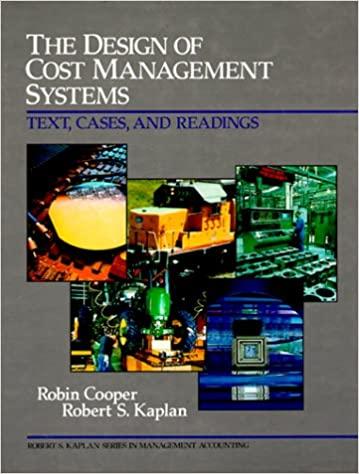Question
1. Which of the following costs is not relevant in a special-order decision? A. Direct labor B. Direct materials C. Variable overhead D. Fixed overhead
1. Which of the following costs is not relevant in a special-order decision? A. Direct labor B. Direct materials C. Variable overhead D. Fixed overhead
2. Costs that change across decision alternatives are
A. accounting costs. B. activity-based costs. C. incremental costs. D. capital costs.
4. The potential benefit of one alternative that is lost by choosing another is known as a(n): A. Sunk cost B. Out-of-pocket cost C. Differential cost D. Opportunity cost
5. A cost that cannot be avoided or changed because it arises from a past decision, and is irrelevant to future decisions, is called a(n): A. Uncontrollable cost B. Incremental cost C. Opportunity cost D. Sunk cost
6. An additional cost that is incurred only if a particular action is taken is a(n): A. Period cost B. Pocket cost C. Discount cost D. Incremental cost
7. The payback period: a. Is the length of time necessary to recover the entire cost of an investment from its resulting annual net cash flow. b. Is the length of time necessary to recover the entire cost of an investment from its resulting annual net income. c. Takes into consideration the profitability of an investment over its entire life, but ignores the timing of its future cash flows. d. Takes into consideration both the profitability of an investment over its entire life and the timing of its future cash flows.
8. Assume ABC Company deposits $25,000 with First National Bank in an account earning interest at 6% per annum, compounded semi-annually. How much will ABC have in the account after five years?
a. $33,598.
b. $25,000.
c. $32,500.
d. $33,456.
9. At the end of two years, what will be the balance in a savings account paying 6% annually if $5,000 is deposited today?
a. $5,000
b. $5,300
c. $5,600
d. $5,618
10. Mordica Company will receive $100,000 in 7 years. If the appropriate interest rate is 10%, the present value of the $100,000 receipt is
a. $51,000.
b. $51,316.
c. $151,000.
d. $194,872.
11. When a projects NPV is equal to zero, the IRR is
A. Equal to zero
B. Greater than the discount rate
C. Less than the discount rate
D. Equal to the discount rate
12. In capital budgeting, depreciation should be added to net income because:
A. Depreciation is a non-cash expense
B. Depreciation represents cash being paid back to the company
C. It represents a gain to the company
D. None of the above.
13. An unprofitable segment should be closed down if:
A. A net loss is reported
B. The segment margin is negative
C. Fixed costs are greater than variable costs
D. The selling price of goods is too low
14. When determining whether to accept a special order:
A. Reject if the special selling price is less than the normal selling price
B. Accept if the special selling price exceeds the variable cost of production, and the plant is at full capacity.
C. Accept if the special selling price exceeds the variable cost of production and the plant has excess capacity.
D. Always reject a special order if the plant is at full capacity.
Step by Step Solution
There are 3 Steps involved in it
Step: 1

Get Instant Access to Expert-Tailored Solutions
See step-by-step solutions with expert insights and AI powered tools for academic success
Step: 2

Step: 3

Ace Your Homework with AI
Get the answers you need in no time with our AI-driven, step-by-step assistance
Get Started


